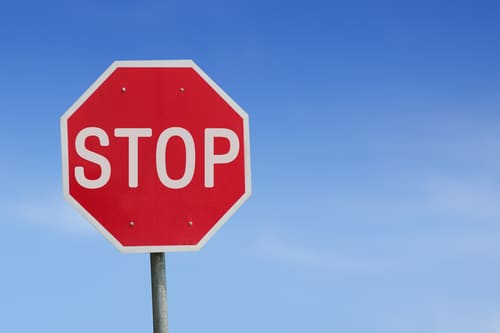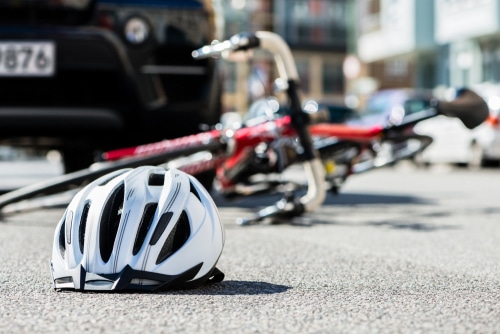* The following article – Understanding Car vs. Bicycle Accident Lawsuits – contains legal information for a general audience, is provided for informational purposes only, and should not be taken as legal advice or legal opinions. For legal advice, always consult with an attorney. *
Understanding car vs. bicycle accident lawsuits can be tricky by nature.
In the state of Maryland, a significant number of accidents involve bicyclists. These incidents often occur due to a lack of familiarity with road regulations on the part of either the cyclist or the motorist.
Regrettably, in the majority of these instances, the consequences are particularly dire for the cyclist. With no barrier separating them from the vehicle that collides with them, cyclists are at increased risk of sustaining life-altering or even fatal injuries in these collisions.
Whether you may find yourself in the driver’s seat, aiming to ensure your compliance with road rules, or you’re a cyclist striving to enhance your safety, an understanding of how Maryland’s traffic laws pertain to cyclists proves indispensable.
When it pertains to ascertaining liability for severe injuries sustained by a cyclist involved in a Maryland automobile accident, it might seem straightforward to attribute fault to the vehicle’s driver. However, this assumption does not always hold true. Determining fault in your Maryland bicycle accident hinges significantly on the specific traffic regulations in force at the time of the incident, and the various facts and circumstances specific to your incident.
Let’s take a look at some commonly misunderstood “rules of the road” between cyclists and motorists.
Maryland Vehicle Laws in Relation To Bicycles

When it comes to determining liability in a vehicle vs. bicycle accident, circumstance and the laws of the road relating to those circumstances are paramount.
With that being said, let’s take a look at some of the aforementioned commonly misunderstood “rules of the road” involving bicyclists.
*All laws are paraphrased or edited. This is general information, and not intended to be a complete summary of all laws regarding bicycle operation in Maryland, or anywhere else. For a list of some of the applicable Maryland laws see here*
Bikes are Treated as Cars
In Maryland, there is a general rule of thumb when determining bicycle vs. car traffic situations. It’s important to keep in mind when driving in Maryland that bicycles, for all intents and purposes, should be treated as an equivalent to a motor vehicle in many typical traffic situations.
As stipulated in Maryland Code TR § 21-1202(a), individuals operating bicycles or motor scooters within public bicycle areas possess the same rights and responsibilities as motor vehicle drivers. Nonetheless, an exception applies to this principle: when a bicycle is within a crosswalk, or is legally on a sidewalk (only in some parts of Maryland) it assumes the status of a pedestrian instead.
Further note: Some counties and/or localities in Maryland allow for bicyclists to ride on sidewalks, even while the general rule in Maryland actually prohibits such. Maryland Code TR § 21-1103(a) – (b).
Right Side Rule
Our first commonly misconstrued law deals with cyclists’ responsibility to remain close to the curb, and when there are exceptions. Maryland’s Right Side Rule (Maryland Code, TR § 12-1205) dictates that:
- When riding a bicycle or motor scooter at a speed slower than the current traffic speed, individuals must stay as close to the right side of the road as is safe and practical. However, there are exceptions to this rule:
- When making or attempting a left turn
- When traveling on a one-way street
- When passing a stationary or slower-moving vehicle
- When avoiding pedestrians or road hazards
- When the right lane is designated for right turns only
- When riding in a lane too narrow for both a bicycle or motor scooter and another vehicle to safely travel side by side within that lane
- Two cyclists and motor scooter riders may ride side by side on a roadway, only if traffic is not impeded.
- When passing a vehicle, individuals operating a bicycle or motor scooter on a roadway must exercise caution and due care
- If there is no sidewalk, individuals riding a bicycle or motor scooter on a highway may walk it on the right side of the road.
Please note that the *Right Side Rule” is not an official name for this law, rather an easy way for cyclists and motorists to commit to memory that cyclists usually have a responsibility to remain as close to the right side of the road as reasonably possible and safe, when traveling slower than the speed of traffic.
3 Foot “Safe Passing” Law
Maryland’s regulations also address how motor vehicles should pass cyclists on the road. Specifically, Maryland Law mandates that automobiles must provide a minimum of three feet of clearance when overtaking a bicycle. (Maryland Code, TR § 12-1209)
However, there are instances where this requirement does not apply, including:
- When the cyclist is not in compliance with Maryland Code TR § 21-1205, which stipulates that cyclists should ride as close to the right side of the road as safely feasible; or with Maryland Code TR 21-1205.1(b), when a cyclist is not using or properly using a paved Bike Lane.
- When a less than three-foot passing clearance distance is caused solely due to the cyclist’s failure to maintain a consistent trajectory.
- When the road’s width does not permit the provision of three feet of space while passing.
The 3 foot safe passing law is designed with cyclist safety in mind, however both cyclists and motorists have a shared responsibility to drive on shared roads.
When is a Driver at Fault for Car vs. Bicycle Accident?
While specific facts and circumstances surrounding the accident are the ultimate deciding factor in determining liability, there are a couple common occurrences where the vehicle driver is often deemed at fault in a vehicle vs. cyclist accident.
Some common scenarios in which the driver may be at fault are:
Left-Cross Crash
A left-cross crash unfolds when a driver executes a left-hand turn at an intersection, often occurring when the motor vehicle and bicycle approach from opposite directions. If the automobile driver fails to observe or notice the cyclist or miscalculate the time available to complete the left turn ahead of the bicycle, the automobile driver may be at fault.
Right Hook Crash
A right-hook crash can transpire when a cyclist travels alongside the right side of a motor vehicle, with the vehicle’s driver not realizing the bicycle is in his or her “blind spot” when initiating a right-hand turn. Despite the cyclist entering or traveling in the vehicle’s blind spot, the responsibility for the collision can frequently fall on the vehicle driver when executing a right turn.
To mitigate the chances of such incidents occurring, drivers should exercise vigilance in areas frequented by cyclists. When appropriate or required, this might include reducing speed, using turn signals, and conducting thorough blind spot checks before making a turn.
When is Cyclist at Fault for Car vs. Bicycle Accident?
Conversely, there are also common scenarios in which a cyclist may be deemed at fault for a car vs. bicycle accident. Some common scenarios include:
Running Stop Signs

One such common scenario in which a cyclist may share the blame, or be found solely at fault, is in an accident when the cyclist fails to stop at a stop sign. As described above, cyclists are usually treated as essentially similar to vehicle drivers and are generally required to obey all standard traffic laws, including coming to a complete stop at a stop sign.
This scenario also encompasses “rolling stops”, in which a cyclist slows, but does not come to a complete stop at the stop sign. If the vehicle has the right of way, and there are no other contributing factors (vehicle speeding etc.), the cyclist may be deemed at fault.
Cyclist Riding Against the Flow of Traffic
Frequently, cyclists choose to travel in the opposite direction of traffic flow, posing safety risks to themselves and oncoming vehicles. Riding against the established traffic direction is prohibited, and in the event of an accident, the cyclist may bear a portion of the responsibility.
In cases where you are not at fault for an accident, the task of substantiating the other party’s negligence can swiftly grow intricate. It is advisable to refrain from acknowledging any culpability at the accident site and, instead, engage in a conversation about the incident’s particulars with a personal injury attorney who possesses expertise in the field of law.
Injured and Seeking Compensation? Hire a Maryland Personal Injury Attorney Today
As you have seen, there are a lot of specific, circumstantial factors that may have an impact in determining who’s at fault in a car vs. bicycle accident claim or lawsuit.
The entire process can be tough to navigate, however it does not have to be. Our team at Jezic & Moyse specializes in personal injury claims, and we have the track record to back it up. Allow our team to focus on your legal needs and gaining the compensation you deserve, while you focus on the important stuff – getting your health back.
Our experienced personal injury attorneys will have your back throughout the entire process, from the time you reach out to us until a resolution is reached.

